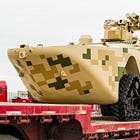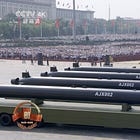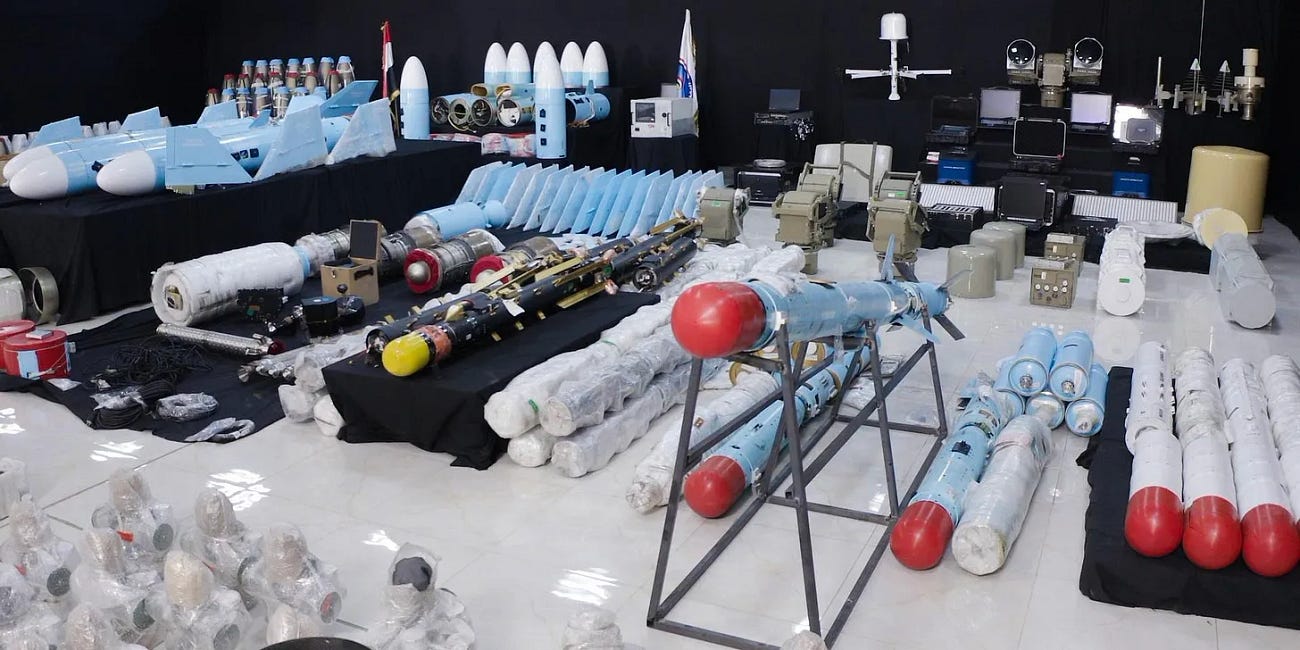On The Potential Of A Sea-Based Strike Munition Launch Capacity For Ansarallah In Yemen
🇮🇷 🇮🇱 🇾🇪 Extensions
This extensions-themed post is an extension of material that has appeared in another newsletter/section and other parts of my website more generally. While my newsletters/sections are primarily categorized by region, these can only appear in one newsletter/section, given how the Substack platform is configured, even as these may be highly relevant to readers who are primarily interested in other parts of the world.
I have long been of the view that Iran and Ansarallah in Yemen prematurely activated the latter’s Iranian-supplied strike munition arsenal against Israel in October 2023. That is, Ansarallah went to war with Israel with the strike munition arsenal it had at hand, not necessarily the strike munition arsenal that the Yemeni armed group and its Iranian sponsor envisaged had more time been available for further transfers of armaments. Much can be said of this widely overlooked dynamic, which highlights the role of contingency in military planning—carefully thought-out plans are often upended by real-world developments. I have covered Ansarallah’s Iranian-supplied ballistic missiles, which the Yemeni group regularly launches in quantities of one and two against Israel, in several writings posted on this website.

Ongoing Transfers of Iranian Ballistic Missiles Enhance Ansarallah’s Long-Range Strike Capabilities
Anyone following current events in the Middle East will likely be familiar with Ansarallah’s regular use of Iranian-origin propeller-driven fixed-wing strike drones to travel distances of 1800 or more kilometers in order to target the southernmost Israeli city of Eilat, which lies along the Gulf of Aqaba, as well as other locations in Israel—Tel Aviv included—more generally. Ansarallah has recently conducted several successful strike drone launches—successful in the sense that these somehow bypassed Israel’s forward defences as well as its point defences despite the heavy concentration of air defence capabilities that Israel has deployed to the Eilat area since October 2023. While I may get around to uploading one or more posts covering such attacks, which I hold to be useful data points for other countries around the world, this extensions-themed post is intended to highlight an approach that Ansarallah is not publicly known to have so far pursued, but one that it may come to pursue and perhaps one that it had planned to pursue with Iranian support prior to the premature activation of its strike capabilities against Israel in October 2023.
In several recent posts, I have discussed how China can use uncrewed surface vehicles (USVs) and/or uncrewed underwater vehicles (UUVs) as forward launch platforms for various strike munitions for use against not only Taiwan but also far more distant targets, such as Papua New Guinea, Australia, and the South Pacific more generally. The second of the following posts notably gives mention to what appears to be an Iranian encapsulated submerged-launch capable propeller-driven fixed-wing strike drone/loitering strike drone, a design that is seemingly intended for use with Iranian submarines and perhaps Iranian UUVs.
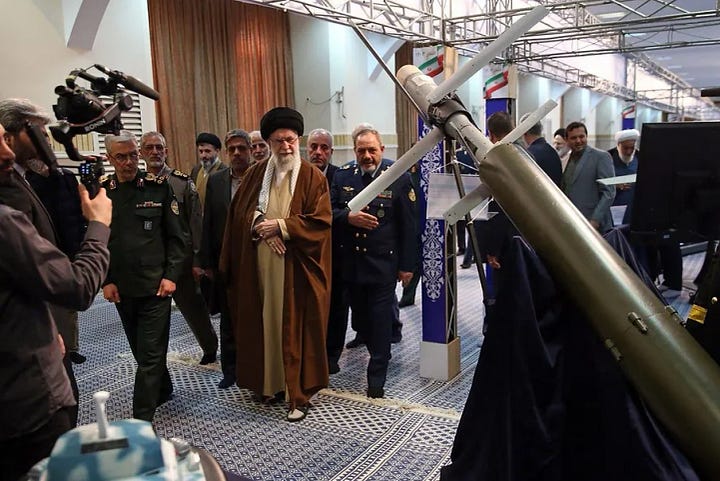


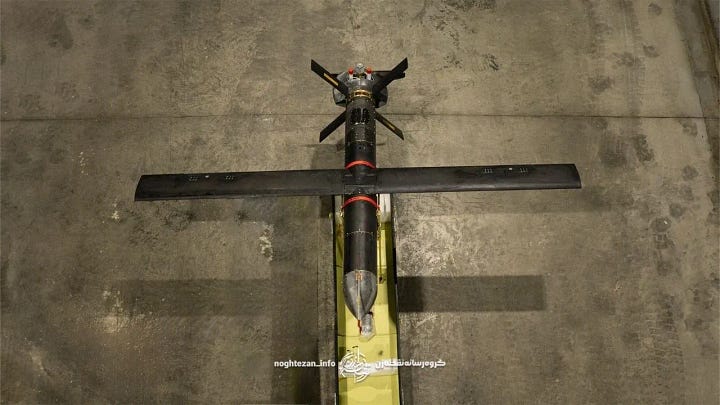
Ansarallah operates both USVs and UUVs, which are likely to either be designs of wholly Iranian origin or designs that have been built in Yemen with considerable Iranian assistance and Iranian-supplied components, and has used both against shipping in the Bab al-Mandeb area. Ansarallah also operates a wide range of Iranian strike munitions, including propeller-driven fixed-wing strike drones and loitering strike drones of various range-payload classes and cruise missiles. Much of what is publicly known about the scope of Iranian arms transfers to Ansarallah since circa 2022 comes from Ansarallah’s occasional disclosures and the interdiction of shipments being sent from Iran to Yemen.
Interdicted Shipment Highlights The Scale And Diversity Of Iranian Armament Pipeline To Ansarallah in Yemen
On 15 July 2025, the Yemeni National Resistance Forces (NRF), which are in opposition to Ansarallah in the frozen conflict that is the Yemeni Civil War, announced that they had interdicted a large shipment of over 680 tonnes of munitions and military equipment that was being transported to an Ansarallah-controlled part of the Yemeni coastline in a dhow.…
It does not take much imagination to envisage how Ansarallah may launch some of its strike munitions from vessels such as USVs. In its simplest form, a sea launch capacity for (some of) Ansarallah’s strike munitions can entail the use of a (crewed) fishing boat or perhaps a (crewed) dhow. With USVs and, to a lesser degree, UUVs already constituting parts of Ansarallah’s arsenal, it does not require much of a leap of imagination to envisage the use of USVs as a forward launch platform. Should such USVs be used in the Red Sea, Ansarallah can significantly reduce the range requirements for its propeller-driven fixed-wing strike drones against Israel. This will facilitate the launch of much larger salvos than is possible when the distance to the southernmost Israeli city of Eilat is over 1800 kilometers if Saudi airspace is avoided. The forward launch of propeller-driven fixed-wing strike drones will also facilitate the targeting of Israel from the west along its Mediterranean coastline with a more diverse array of strike munitions. Ansarallah is understood to currently rely on the Iranian-origin extended-range Yafa propeller-driven fixed-wing strike drones to attack very distant targets such as Tel Aviv.
It is important to recognize that none of this is beyond the realm of possibility. A USV along the lines of those that Ukraine is employing against Russia in the Black Sea, which is to say USV designs with a maximum range of 800-1000 kilometers—Ukrainian designs that are optimized for a high maximum speed—can follow the Sudanese coastline to a launch position that is more or less across the Red Sea from Jeddah. Eilat is some 1000 kilometers from such a notional launch position, while Tel Aviv will be around 1350 kilometers from such a notional launch position, providing that the propeller-driven fixed-wing strike drone flies over the Sinai Peninsula to reach the Mediterranean. Should Ansarallah and, by association, Iran pursue such an approach, they will be able to reshape the regional air defence environment once more.
While this post focuses on Ansarallah’s strike capabilities, it is very much intended to highlight how we are dealing with nothing other than universal dynamics, which is not incidentally the title of this website. Technological change and the diffusion of knowledge and capacity to develop and build many types of armaments, more generally, is fundamentally reshaping military dynamics worldwide. It is inaccurate to say that we are approaching a situation in which essentially anyone and everyone may possess some form of long-range strike capability, given that this is essentially the world as it currently exists, not least at a time when commercial satellite internet providers such as Starlink are dramatically lowering the technological hurdles encountered to developing a long-range USV, a long-range propeller-driven fixed-wing strike drone, or a long-range USV that can be used to launch a long-range strike drone.
Will The Gulf Arab Countries Approve Starlink LEO SATCOM Amid The Mounting Iranian Strike Munition Threat?
The American company SpaceX offers satellite internet service in much of the world through its constellation of Starlink communication satellites. Although commercial satellite communications (SATCOM) is not new, Starlink is the first fully operational SATCOM service to utilize satellites that are located in low Earth orbit (LEO). While this forces Spac…



